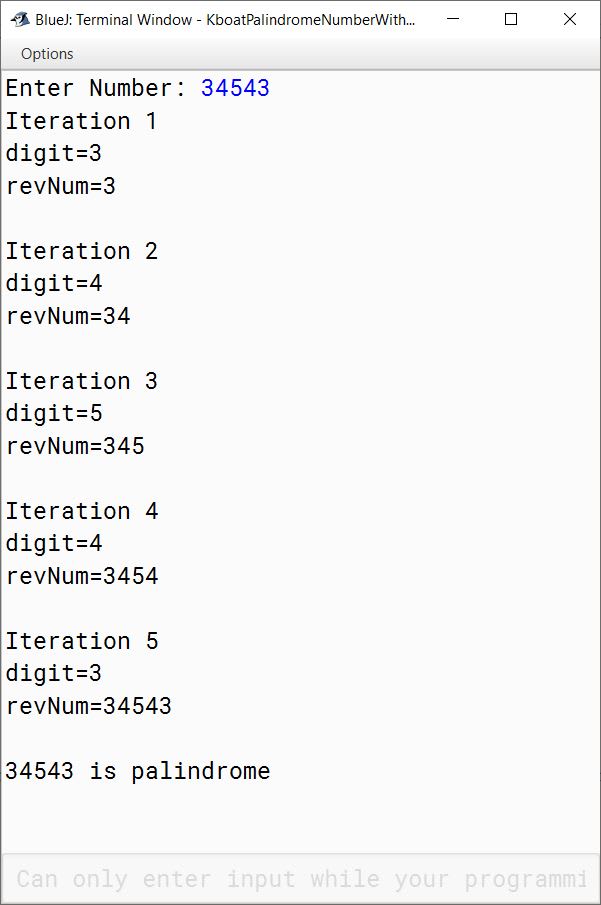What is a Palindrome Number?
In this lesson, we will look at palindrome number program. A number is said to be a palindrome if it remains the same when its digits are reversed. 747, 121, 48984, 34543 are some examples of palindrome numbers.
Palindrome Number Program
This is the program to check if a given number is a palindrome or not.
import java.util.Scanner;
public class KboatPalindromeNumber
{
public void checkPalindrome() {
Scanner in = new Scanner(System.in);
System.out.print("Enter Number: ");
int orgNum = in.nextInt();
int copyNum = orgNum;
int revNum = 0;
while(copyNum != 0) {
int digit = copyNum % 10;
copyNum /= 10;
revNum = revNum * 10 + digit;
}
if (revNum == orgNum)
System.out.println(orgNum + " is palindrome");
else
System.out.println(orgNum + " is not palindrome");
}
}Let's go over the program to understand it. In the below lines of the program:
Scanner in = new Scanner(System.in);
System.out.print("Enter Number: ");
int orgNum = in.nextInt();
int copyNum = orgNum;we accept the number from the user with the help of scanner class and make a copy of it in variable copyNum to preserve the original input. After that we have the while loop:
while(copyNum != 0) {
int digit = copyNum % 10;
copyNum /= 10;
revNum = revNum * 10 + digit;
}Inside the while loop, we are extracting each digit of the number into the int variable digit. The extraction of digits of a number is explained in detail here.
The line revNum = revNum * 10 + digit; is reversing the number digit-by-digit. To understand how this line is reversing the number, let us add a few statements to print the value of digit and revNum at each iteration of the while loop. Below is the program with the additional print statements added and its output:
import java.util.Scanner;
public class KboatPalindromeNumber
{
public void checkPalindrome() {
Scanner in = new Scanner(System.in);
System.out.print("Enter Number: ");
int orgNum = in.nextInt();
int copyNum = orgNum;
int revNum = 0;
int itr = 1;
while(copyNum != 0) {
int digit = copyNum % 10;
copyNum /= 10;
revNum = revNum * 10 + digit;
/*
* Additional Print Statements
* for explanation
*/
System.out.println("Iteration " + itr++);
System.out.println("digit=" + digit);
System.out.println("revNum=" + revNum);
System.out.println();
}
if (revNum == orgNum)
System.out.println(orgNum + " is palindrome");
else
System.out.println(orgNum + " is not palindrome");
}
}Output

As you can see in the output above, in the first iteration, the digit in the unit’s place which is 3 is extracted. Current value of revNum is zero, so the line revNum = revNum * 10 + digit; multiplies 0 with 10 and adds the value of variable digit to it effectively storing digit in revNum. revNum now becomes 3 which is shown in the output of the first iteration:
revNum = revNum * 10 + digit;
revNum = 0 * 10 + 3 [∵ digit = 3]
revNum = 0 + 3
revNum = 3
In the second iteration, the digit 2 is extracted. revNum is 3, multiplying it with 10 and adding 2 to it gives us 32 as shown in the output of the second iteration:
revNum = revNum * 10 + digit;
revNum = 3 * 10 + 2 [∵ digit = 2]
revNum = 30 + 2
revNum = 32
Notice that by the end of second iteration, we have reversed 2 digits of the number.
In the third iteration, the digit 1 is extracted. Current value of revNum is 32 and it is changed to 321 as shown in the output:
revNum = revNum * 10 + digit;
revNum = 32 * 10 + 1 [∵ digit = 1]
revNum = 320 + 1
revNum = 321
At this point, we have successfully reversed the number.
After third iteration, number becomes zero, so the while loop completes. Program control moves to the if-else after the loop. We compare the reversed number with the original number, if both are equal then number is a palindrome otherwise it is not.
Let us run the program with a palindrome number 34543 as input and verify that the program correctly identifies it as a palindromic number.
